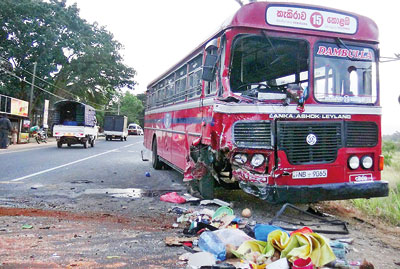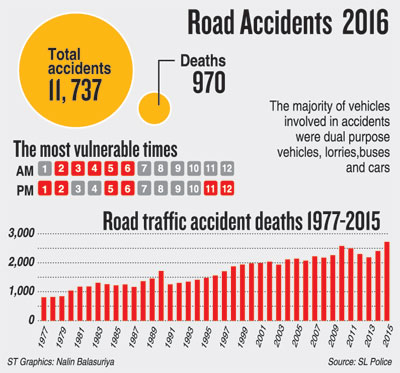News
10 deadly accidents in the past two weeks

A recent accident in Dambulla
Young people have been the main casualties in more than 10 serious accidents around the country in the past fortnight.
On Friday morning, four people including a young driver and a child were killed and six others injured when a van transporting people to a church festival in Polonnaruwa was wrecked after hitting an oncoming Sri Lanka Transport Board (SLTB) bus in the Galewela area.
Initial investigations revealed the van driver had fallen asleep and the vehicle had wandered into the opposite lane and hit a bus although the bus driver had tried to avoid the collision. “Persons going on long distance journeys should always be concerned about the driver of the vehicle and ensure that he has had proper sleep and is in good condition to continue a long journey. People who leave on early trips usually fail to look into the condition of the driver,” a senior police officer in the Kurunegala division said.
Police statistics show 970 people have died in 11,737 accidents so far this year.
The National Council for Road Safety (NCRS) points out that road accidents are the main cause of death among those aged 20 to 28 years.
Last year, more than 2,700 people were killed in more than 36,000 road accidents – an increase of more than 300 from 2014. This toll included 903 pedestrian deaths, 954 cyclists, 465 motorcyclists and 287 pillion riders.
Most accidents occurred at 2-6am, 1-2 pm, 5-6pm and 11-12 midnight, Deputy Inspector General Amarasiri Seneratne, who was previously in charge of traffic, said.
Pedestrians and drivers were both indifferent to road rules and regulations, he said, adding: “The road rules are in place to benefit everybody. Pedestrians are often careless and reckless.”
At present, there is intense enforcement but it is not applied consistently or equally. Police are now watchful at pedestrian crossings.
An NCRS official said drivers of buses, containers and lorries were often former conductors, cleaners, helpers etc. and were not professionals and that most learning occurred through trial and error. “There is no mid-career training,” the official said, adding that road safety training should be made compulsory for drivers He said drunk driving had decreased substantially due to strict surveillance by police.
A 2013 study conducted by the Health Ministry into the methods used by drivers to combat sleepiness/drowsiness showed that 28 per cent smoked, 10 per cent stopped for a cup or coffee and 62 per cent continued driving despite feeling fatigued as they felt confident of completing their journey safely.
Smoking and drinking coffee did not overcome drowsiness, Dr. T. Thuthikaran of the National Hospital in Colombo stressed. Having regular medical checkups avoiding alcohol and illicit drugs, are among the best ways to prevent fatigue, he advised.
Late last week two people died and nine were injured when a car collided head-on with a van on the Puttalam Road at Arachchikattuwa. The deceased, who were in the car, were residents of Tellipalai Jaffna.
A 55-year-old trishaw driver in Balangoda was killed when his vehicle collided with a private bus plying the Colombo to Balangoda route
“Roads are carpeted for high speed and smooth surfaces are laid over old ones which had a safe speed of 50-60km. This gives the drivers a false sense of security,” the Head of the Department of Transport and Logistics Management at the University of Moratuwa, Dr. T. Sivakumar said.
“About 26 per cent of accidents are caused by drivers without driving licences,” he added.
It is vital the government wakes up to the very real and human consequences of inadequate action on road safety and moves quickly to address the biggest killers on our roads,
Evidence shows one in five new drivers have a crash in the first six months after passing their test,” the Secretary of Automobile Association Ceylon (AAC), Dewapriya Hettiarachchi, said, calling for further training
for young drivers after they
qualified.
“Many people haven’t driven at night or in bad weather conditions and haven’t driven with other people in the car. That is not part of the test. That becomes a problem when they get into their car with a licence for the first time,” Mr. Hettiarachchi said.

